Cultural architecture engages future of Taipei City
By Gloria Cho Three buildings in Taipei were all ambitiously designed to break architectural limits and morph into contemporary venues that would be massively involved in the city's evolution. The buildings, namely, Taipei Performing Arts Center (TPAC), Taipei Pop Music Center (TPMC), and Taipei New Horizon (TNH), are all either newly constructed or undergoing construction and will be on exhibit in Flora Park until October 13. Rubik's Cube : Taipei Performing Arts Center Nicknamed "Rubik's Cube," the TPAC boasts a new and flexible theater construction. The three-in-one architecture consists of three theaters—a grand theater with 1,500 seats, along with a proscenium play house and multiform theater, both housing 800 seats each. A central cube connects these three units, the consolidating stages, back stages, and facilities as a whole. In addition, TPAC also welcomes visitors without having to purchase a theatre ticket. Strolling on the passage that runs through the theatre infrastructure and production areas, visitors will be lent a peek into the backstage action, normally hidden but equally impressive as the front stage. The design reaches a broader public since it enables the audience to personally experience the production first-hand. All the concepts raised by the architecture team, OMA, revolve around the motif of "Experimental Characteristics," which was derived from a special type of dual-flavored hot pot often sold in Taiwan's night markets. OMA challenges the conventional concept of "theater" and replaces them with the concepts of "specificity" and "free definition." "We are ambitious of the project, which is very experimental and will exist compatibly with the night market nearby," said Rem Koolhass who is OMA's Partners-in-charge of the project. Situated near Jiantan MRT Station on site of the former Shihlin Night Market, the 25-hectare TPAC is expected to unite sightseeing, civic culture, and cultural affairs to promote performing arts in urban life when it is completed in 2015. TPAC expects to serve as a platform for performing art by efficiently combining performing troupes, the audience, and facilities. To reach this goal, effort has been put into cultivating new talents, while integrating existing projects such as the Taipei Arts Festival, Taipei Children's Art Festival, and Taipei Fringe Festival so as to reinforce international exchange and development. A tribute to contemporary music: Taipei Pop Music Centre Located on Shimin Boulevard next to the Tree-rail Terminal's Nangang Station, TPMC's structure is based on the concept of reflecting local lifestyle and aesthetics into an urban open space equipped for various functions including music, fashion, creativity, trend, and leisure. The architecture was planned as a multipurpose venue, covering an entire area of 8.97 hectares. The entire facility will consist of the Main Hall, the Hall of Fame, and the Industry Shell. The medium-sized Main Hall can seamlessly adjust to the growing industry by accommodating 5,000 seats. The Hall of Fame functions as an archive of pop music history and also holds a display space, while the Industry Shell is designed for interchanges and educational purposes. The Live House has a seating capacity of 1,600, 800, and 200, along with a music restaurant, all set up within the shell. In addition, an elevated pedestrian zone was designed to bridge and effectively join the three units, whilst connecting people to the life of the city. "This will be an iconic project -- people will recognize the place when they visit Taipei," said Reiser. In terms of production, a music industry promotion committee was founded to establish a catalog of 110,000 songs and record interviews of 68 veteran artists. It also helped to screen music performing spaces while assisting nearly 20 music halls adhere to related regulations, according to the Department of Cultural Affairs, Taipei City Government. It's expected that various performing spaces catering to growing demands will make TPMC both an interchange platform among performers and a institution for cultivating pop music talent. Cradle of cultural creativity industry: Taipei New Horizon TNH was designed by internationally renowned Japanese architect Toyo Ito, recipient of the Pritzker Architecture Prize in 2013. It is planned to coexist harmoniously with the nearby Taipei Songshan Tobacco Plant historical site. Structurally, TNH's exterior arc layers shrink in size to create more open space and decrease the gap between the building and people. The structure serves as much more than a base for cultural creativity industry. It's also fully capable of satisfying the leisure needs of citizens with its interior offices, themed hotels, shops, movie theaters, auditoriums, and more. TNH was also honored with the 12th Gold National Architecture Award for public buildings. In the light of overall landscape, the color green is introduced from outside to the walls, terraces, and base. Furthermore, to enhance expression, various colors like bright green, orange and red are used on the building. As an open asset for the cultural creativity industry, TNH is expected to serve as a multi-platform catalyst that will accelerate interaction among creators, operators, and consumers. The sustainable development of cultural creativity industry become possible with these open channels of creation/research and development, production/publication, and marketing. What will Taipei be? Construction of these buildings is not the only focus; The interaction of buildings with people along with development of the creativity industry carries more weight. Therefore, visitors can watch documentaries on Mandarin pop music history, screen major art festivals and more in the TPMC section; Visitors to TNH can also view a film on the Taipei Songshan Tobacco Plant and its reformation into Songshan Cultural and Creative Park. Upon the completion of construction, TPAC, TPMC, and TNH will join Taipei's ever growing list of important cultural assets. In addition to being merely a container for people, they are more like bases for designers and builders to preserve history, cultivate aesthetics, and nourish creative ideas. They bear the expectation of becoming the forerunners in triggering a city's revolution. A session on architecture will also be held 2 pm on October 5 at the Taipei Flora Expo Park 1st floor conference room. The exhibition will run until Oct. 13 at the park. For more information please visit www.facebook.com/Taipei.City.Museum. (in Chinese)
Staff Writer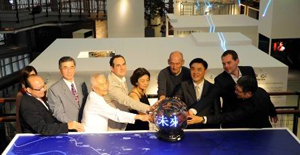 A city is principally formed through a cluster of people, and architecture plays an essential role in the process. However, as a container of various activities, what other functions does a building have besides conventional usage?
A city is principally formed through a cluster of people, and architecture plays an essential role in the process. However, as a container of various activities, what other functions does a building have besides conventional usage?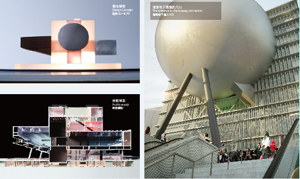 Each unit can be operated separately, or the partition between the grand theater and the multiform theater can be removed to create a super theatre. The design allows the stages to be adjusted or merged for a variety of unexpected scenarios.
Each unit can be operated separately, or the partition between the grand theater and the multiform theater can be removed to create a super theatre. The design allows the stages to be adjusted or merged for a variety of unexpected scenarios.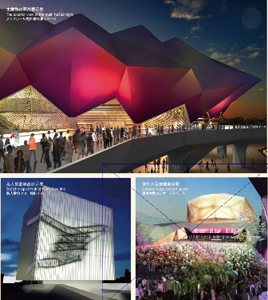 An original idea that there should be a venue dedicated to the celebration, production, and reception of Taiwanese/Asian pop music has led to the birth of the TPMC. The three-in-one complex was designed by the RUR Architecture PC, headed by Jesse Reiser from the US and the local Fei & Cheng Associates.
An original idea that there should be a venue dedicated to the celebration, production, and reception of Taiwanese/Asian pop music has led to the birth of the TPMC. The three-in-one complex was designed by the RUR Architecture PC, headed by Jesse Reiser from the US and the local Fei & Cheng Associates.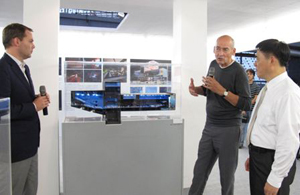 Taipei city has been exerting every effort in nourishing its cultural creativity during these past few years and the environmentally friendly TNH, with 14 floors above ground and four floors below, is a worthy addition to its accomplishments list. Located in the Songshan Cultural and Creative Park, TNH was co-founded by Fubon Land Development Co., Ltd and Taiwan Mobile Co., Ltd in 2009.
Taipei city has been exerting every effort in nourishing its cultural creativity during these past few years and the environmentally friendly TNH, with 14 floors above ground and four floors below, is a worthy addition to its accomplishments list. Located in the Songshan Cultural and Creative Park, TNH was co-founded by Fubon Land Development Co., Ltd and Taiwan Mobile Co., Ltd in 2009.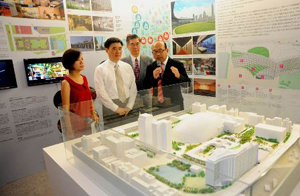 The focal point of the exhibition named "Taipei will be……" is to explore these three buildings - Taipei Performing Arts Center, the Taipei Pop Music Center and Taipei New Horizon. Each uniquely represent the senses of performing arts, pop music and creative arts of the city, while allowing visitors and locals to experience the thriving and ever-changing city of Taipei.
The focal point of the exhibition named "Taipei will be……" is to explore these three buildings - Taipei Performing Arts Center, the Taipei Pop Music Center and Taipei New Horizon. Each uniquely represent the senses of performing arts, pop music and creative arts of the city, while allowing visitors and locals to experience the thriving and ever-changing city of Taipei.

![Taiwan.gov.tw [ open a new window]](/images/egov.png)
